Text
Race Report: Kullamannen Ultra 100 Miles, 2018
A 100 mile (161 km) long course in Skåne Sweden passing through three magnificent nature reserves with a grand finish at Kullaberg and Ladonia. Also calls itself a race of "HEAVEN, OCEAN & HELL".

What did you guys get up to this year leading up to Kullamannen? Torbjörn: I had a near perfect start to the year building up to April. Some minor kinks relating to various ailments brought home from kindergarten by my kids but nothing too bad. I Started off the race year with TEC 100 in April. I had attempted this race in 2016 and dropped after 103km due to motivational issues. This DNF has been a thorn in my side ever since. I needed to get it done and off of my mind. TEC 100 was still as boring as I remembered but I was way more motivated this time around and managed a sub-22h finish thanks to Kristian Ekfors’ excellent pacing. After TEC I got in a solid training block before High Coast Ultra in July. High Coast Ultra is a technical 129km point to point race from Örnsköldsvik to Hotel Höga Kusten on the Höga Kusten trail. This was a very beautiful race running through some of Sweden’s most spectacular scenery. I ran the first 100k with Martin Ström until my bad bonk temper forced us to separate but the last 15k felt good. Fuelled by adrenalin I battled out a sub 18-hour finish. Robert: After extraordinary lottery luck I was signed up for both Western States and UTMB in 2018. I fought a tedious calf strain early in the year and the first real test of the muscle was Ursvik Ultra 45k in March. The calf didn’t mind the ice/slushy course which gave me confidence to start serious training resulting in the best volume block so far. That paid off at Western States where I had what felt like the race day of my life, finishing under 22 hours and earning a silver buckle. Still feeling physically good after the recovery from the race I put in a training block before UTMB. The race went reasonably well. Despite mental fatigue, my experience and using split times from the year before as well as my good training condition Ied to bettering last years’ time by almost three hours. Neither of you have ran this race before. Why did you sign up for Kullamannen 100 miles? T: After a short break post-High Coast Ultra, I felt surprisingly fresh and bounced back to a reasonable volume with no real purpose. This made me ponder what races are available that won’t cause too much hassle regarding travel and time away from my family. I talked with the other boys of DOA and Robert suggested I run Kullamannen with him, provided he wasn’t too wrecked after UTMB. If you would have asked me a year earlier I would have laughed at the prospect but the technical and more demanding type of races is an increasing temptation. So, I asked around I Kullamannen 100 miles facebook group (registration was already closed at this point) and immediately got an answer from an acquaintance who sold me his spot due to an injury. The fact that Kullamannen also was rewarded 6 UTMB-qualifying points this year was icing on the cake. R: I honestly don’t remember. Looking through my mail I must have signed up at the end of April, either drunk or overambitious and persuaded by the race’s notoriety as “Sweden’s toughest 100-miler”. Then I made the mistake of suggesting the race to Torbjörn and I was suddenly committed. What were your strategies specific to this race? T: My plan was basically to finish the race before cut off. I had heard from last year’s participants that it was tough and some of the up-hills were really steep but the accounts all seemed pretty abstract unseen. Nutrition-wise I just had a lot of chews, gels and chocolate bars because that usually works. My back-up plan is always salt-tabs and water and the occasional gel. R: I wasn’t too worried about running another 100 miles, especially since I didn’t have any ambitious time goals. But the lack of aid stations made me a bit anxious. The most recent races spoiled me with the quantity and the quality of the stations. It’s been a while since I had eaten a gel during a race and this time I realised I probably had to depend on portable nutrition. I got the newly released Maurten Gel but also stocked up my vest and the drop bag with lots of Snickers, Bounty and Red Bull. Let’s talk about the race then. Start to Ängelholm (0-50km): T: I fell asleep the night before at 10pm but woke up at 3am and couldn’t fall back to sleep. Not the best start but I’ve had worse. R: I slept like a baby. Torbjörn woke me up with his alarm clock. T & R: After the initially hilly start, we followed the shoreline at a 6 min/km pace enjoying the company of fellow runners. We kept this up until Ängelholm, the first drop-bag station at 50km. T: I noticed that I was surprisingly fatigued from 35-50km, probably from being unaccustomed to running at a static pace on a flat surface for an extended time. T & R: We had some sandwiches and soup and packed our headlamps at Ängelholm. It was only around 2pm but the sunset is as early as 3:30pm this time of the year here. The upcoming stretch would include a woodland section with lots of twists and turns.



Ängelholm to Mölle (50-100km): T: I ate way too much at the aid station and struggled to get back to running form for at least 6-8k. Robert was at the front setting pace and I was struggling to keep up. Eventually we decided to part ways. I teamed up with a couple of other people we had met earlier in the race and we kept company off and on up until aid station Svanshall @76k. After Svanshall the terrain changed dramatically, single track and steep technical sections were increasing. I kept company with a couple of runners (Anders W. and Maria N.) the first half of the 0.5 lap of “Kullavarvet” (the loop out on the Kulla peninsula). After a dense woodland jaunt, we reached the infamous Dödsbacken for the first time. Three sections of incredibly steep rope assisted climbs, followed by a couple of gruelling hand-to-dirt climbs was fun and hard! The second half from Dödsbacken past the lighthouse and to Mölle were varied but challenging terrain, ranging from technical woodland to rocky beach. Arriving at Mölle I was happy and hungry, I ate too much (again) and tried to keep out of the negative spiral of DNF-talk before heading out on the loop. R: I felt pretty good after Ängelholm, jogging along but noticing Torbjörn lagging behind a bit. We had a chat and separated on mutual terms. At 100 miles you have to run your own race and the highs and the lows will never be synchronised. A couple of hours later around Svanshall aid station I struggled mentally and physically, my quads hurting and my motivation being drained from running endlessly on flat ground. At that point I considered a DNF, already formulating Strava posts in my head. I wouldn’t DNF right away but entertaining the idea of quitting at at Mölle aid station kept me going. Ironically, giving myself the permission to quit the race actually made the race more enjoyable. Running through small bushy trails, hiking up and stumbling down steep woodland hills riddled with briars, I somehow regained energy. Passing quite a few people on the ridiculously steep uphills certainly helped. Arriving in Mölle, the place where I had planned to end my race, I felt strong and rejuvenated and decided to do continue with the three loops. Or at least one.

The loops (22km x 3): R: I met Micke H at the aid station. He was about to head out on his first loop so I hurried out to have some company. A few kilometers later, it became obvious that he was struggling with stomach issues. He convinced to me go on without him, so I ended up on my own again. I really loved the wild mix of runnable paths through beech forests and the steep rope sections. At that point my tendency for “ultra-math” kicked in and I measured the loop to be 22km and have 800 meters of elevation gain. The first loop took me 3 hours and 22 minutes. I felt great. Finishing the second loop just a bit under 4 hours, I met Andreas Petterson at the aid station, whom I knew mostly from Strava/Instagram. He was sitting on a bench and I gave him a pep-talk on how close we were to finishing sub-24 hours. He was slightly skeptical but followed along out on the loop. We took turns pulling and dragging each other the first half of the loop. After the steep ascends Andreas struggled a bit and we separated. I wasn’t at my strongest either but kept myself alive by religiously calculating a sub-24 finish. 12-minute pace, wasn’t it? I wasn’t sure. At the lighthouse, 4km to go, I had 55 minutes left. Easy. The sun was rising and wow, how beautiful this part of the loop was. I took a few photos and the next time I checked I had still 4km but only 45 minutes left. Time to move. I walk-jogged towards Mölle and finished in just 9 minutes short of 24 hours. Yay! T: The intake of chocolate milk, chia-pudding, rice and broth and sandwiches made the first part of loop #1 painfully heavy. I struggled with walking the runnable parts and trying to make up time by power hiking the steep woodland climbs. The super steep rope section was oddly quite refreshing and though I had some mental lows I still felt no reason whatsoever to quit. I was already struggling with sleep deprivation and this was about to worsen. The second part of loop #1 is hard to recollect but I kept my head down and struggled on. I reconciled with the fact that this was not going to be fast but I would get the job done before cut-off if nothing out of the ordinary happened. My best headlamp lasted only a bit into the first loop and I was forced to use my secondary headlamp 70% of the dark hours. In the pitch black you don’t need a ton of lumens but it was still a bit too weak. Having made the repeated mistake of eating too much food at aid stations, I decided to go easy on it at the next Mölle passing. I skipped the Gainomax (whey protein chocolate milk) and tried to chill a little bit with intake all around. Micke H and Anders H were heading out again and waited for me (much appreciated). But, I was really low mentally and energy-wise everything felt heavy. The first runnable part after the passing went slowly (again) and my morale was dropping. I was really tired, yawning myself to breathlessness. I had to tell Micke and Anders to drop me, I needed time by myself (sorry guys) and fucked around with changing batteries in my lousy headlamp, adjusting clothing and generally wasting time. This lap was really lousy, I felt like I was sick of the night running and longed for the daylight. Approaching the lighthouse at sun-up raised my spirits. I tried to refuel moderately at Mölle and went out happy and determined to finish strong. I ran all the runnable parts leading up to the technical woodland. I ran past a couple of friends and they laughed at my enthusiasm (maybe a bit too enthusiastic). I tried to keep up the tempo, and the daylight gave me lots of energy. It was really hard, but the final lap gave me confidence. The pain I felt was not relating to anything specific, and damnit, I was too close to the finish line to even bother about earthly worries. The realization that if I kept going I would finish under 28 hours made me even more determined. I took time to relish and have fun the last couple of scenic coastal kilometers and ended up finishing with a 4-hour lap.


Any last thoughts looking back on the race? R: Really happy with my performance, trying to analyze what kept me going beyond my mental low point half way in. Despite its label as Sweden’s toughest 100-miler, it’s a wonderfully fun and beautiful course and just the right mix to never get boring. After Western States and UTMB I didn’t have much mental fortitude or what we in Sweden call “pannben” left, but luckily I ended every loop on a mental high point, stoked to start another one. T: Wow, what a ride. I’m so happy that I ran this race. Kullamannen is challenging, sure, but it is varied and the second half is so much fun! Slow but fun. I’m surprised by how much I enjoyed feeling miserable on the steep hills in the dark. As soon as the sun rose I was rejuvenated and energized. Night running is still difficult but I’m appreciating it more and more. Two major lessons learned: Buy a new stronger headlamp with easily exchangeable battery/batteries, don’t over-eat at aid stations, carrying food and eating it a little at a time should do the trick. Robert's Strava

Torbjörn's Strava

0 notes
Text
Race Report: UTMB, 2018 or (How I learned to stop worrying and ran 2 races in 70 days)
When I won the starting place for Western States 2018, I thought I had used up all my race lottery luck for this year. Little did I know that I’d get into UTMB as well, second year in a row. Once the initial excitement subsided, I was faced with a small challenge. The races are only about two months apart and they feature dissimilar profiles and terrains. How would I go about training for both? The short version: I opted to focus on the more “run-able“ WSER first, then reassess in July.
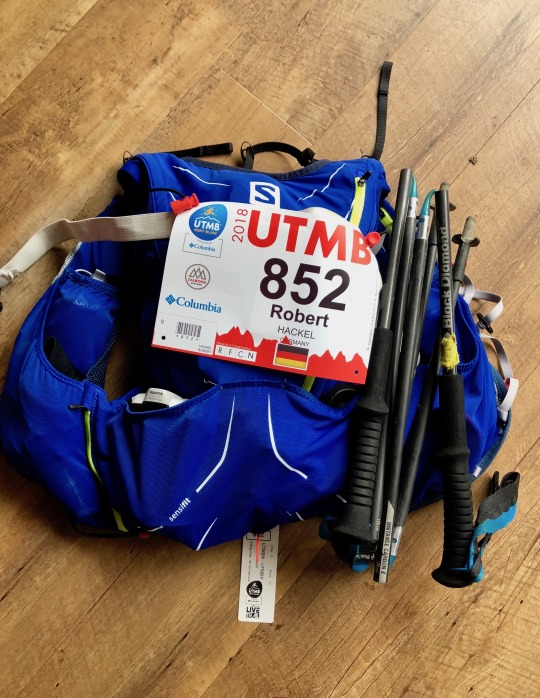
Relying on the base training laid down for WSER, the 10 weeks leading up to UTMB concentrated on recovery, slowly increasing my mileage in a reverted taper and just listened to my body. There are dozens of training plans for marathons and ultra-marathons out there but they are mostly tailored for one race, not two races in fairly quick succession. A few weeks after WSER, my legs regained their freshness and I began to incorporate hill repeats: hiking up with poles, running down steep slopes fast, chasing some Strava KOMs. In hindsight, I may have done the latter a bit too vigorously as my hip flexors, lower back and quad muscles felt a bit stressed 2-3 weeks away from the race. Uh oh. Regardless, I still felt pretty strong and confident overall when I entered the tapering phase. Time to pack. A quick summary of UTMB 2017: As mentioned, this was my second year in Chamonix. Martin and I completed the race together last year in 34:53, just a handful of minutes under the 35 hour goal we set for ourselves. It was an especially cold year and we even encountered a blizzard on one of the peaks. It was tough and unforgiving. I forgot my poles at one of the stations and to double back to retrieve them. That sucked. Took a short nap. Felt refreshed. Started to lose our minds a little on the second night. Hey, we finished.
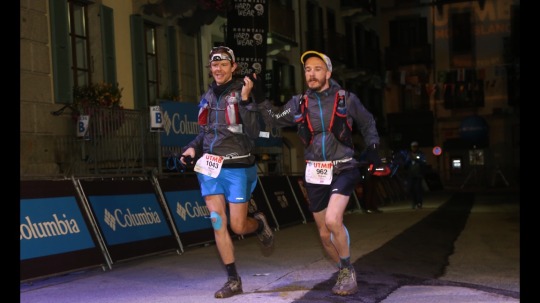
As an “experienced” UTMB runner, my goal for this year was simple. Improve on the previous year’s record. I really took my time at aid stations, sticking around for 30 minutes at some places. I don’t necessarily regret that for my first attempt, but if I keep the dawdling to a minimum, it just might be possible to shave off an hour or so. And the weather was looking more favourable this time around. Even better.
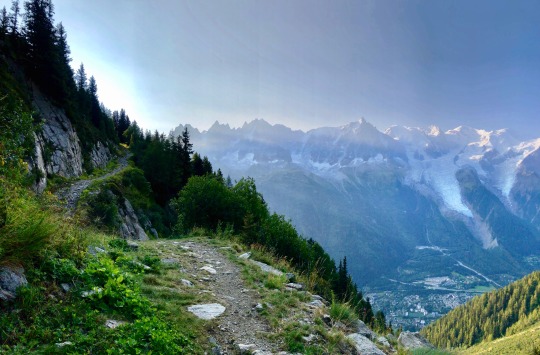
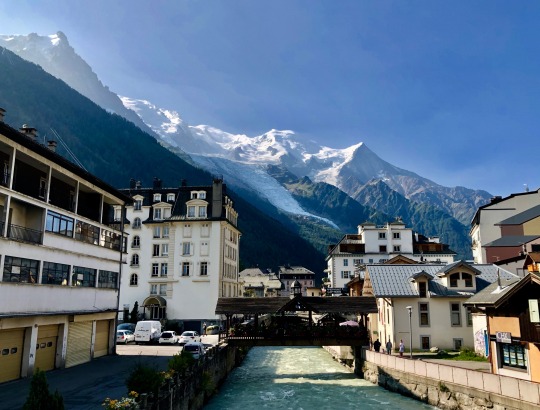
I arrived in Chamonix on Monday and did a couple of short runs and hikes with my girlfriend during the week leading up to the race. The excitement of the race week in Chamonix was coming back to me: the tension, the dramatic silhouette of the mountains, thousands of runners from around the globe, the weather. THE WEATHER. As Friday approached, the weather prognosis worsened and the dark clouds hanging low over Mont Blanc brought back the fears and traumatic memories from 2017. Cold, rain and with bad visibility. Frozen fingers. Shudders.
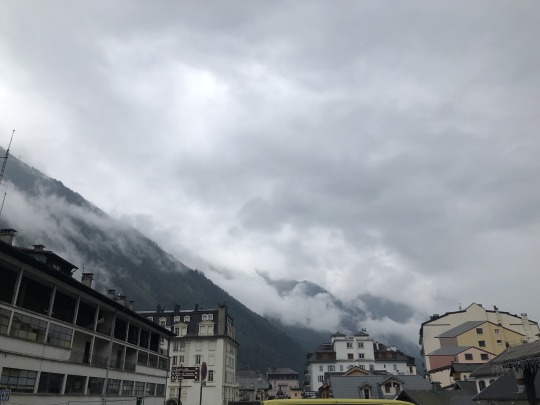
I guess I did indeed use up my luck this year on the race lottery. With not much to do after lunch except to anxiously pace around the hotel room, I headed out to the start line two hours early. Why not. A good spot would save me the queueing later. Unbeknownst to me at the time, it also meant standing in the rain for two hours. Just like the year before, the atmosphere was a bit like we were going to war than going to enjoy a trail race. Eventually, Conquest of Paradise played over the PA system and the gun went off. As I was positioned more or less directly behind the seeded runners, I found myself running amidst a pretty fast group at 4:40 min/km pace for the first 3km. Stupidly fast, I thought. I dropped back and fell in with a group running at a more comfortable pace all the way to Les Houches. With the cheering crowd giving me all the motivation I needed, I took on the first climb.
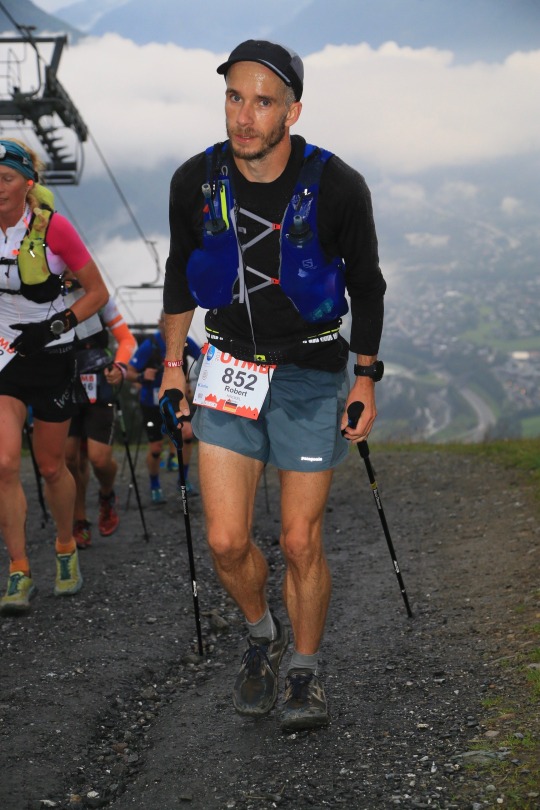
I had my splits from 2017 laminated in my pocket to keep track if I was going out too fast or needed to make up time. My plan was to take it easy until Courmayeur (80km) and keep something left in the tank for the latter half of the race.
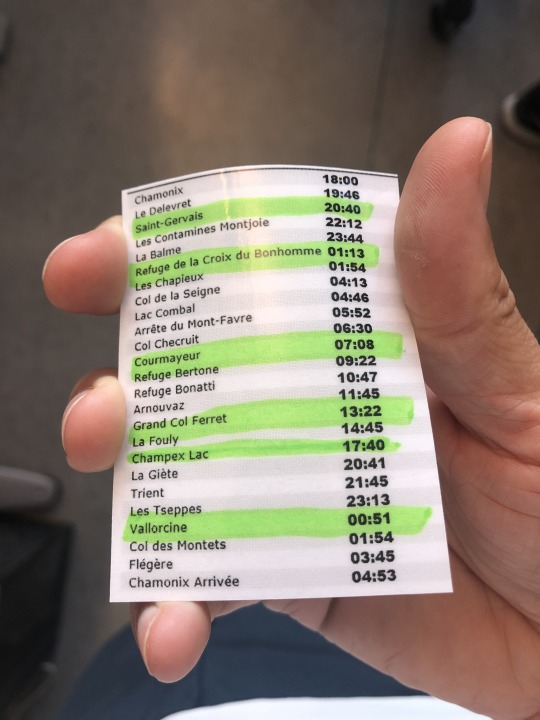
Nevertheless, I arrived 15 minutes ahead of last year’s time in St. Gervais and 22 minutes ahead in Les Contamines (32km). Physically, I was fine but mentally I felt my motivation slipping. The rain came down harder over the first climb and I dreaded going into the night in the worsening weather condition. There is a commuter train from St. Gervais to Chamonix. Maybe it’s still running. A taxi from Les Contamines. Surely, the €50 I have tucked away in my vest for emergencies should be enough. Alas, I didn’t have a solid reason to DNF. Not yet. I can’t quit because of rain. Not while my legs felt fine. But knowing how long the journey ahead is, knowing how it was last year, just knowing was becoming a burden. Sometimes, experience isn’t an advantage but an obstacle. As I continued the endless climb up away from Les Contamines with these thoughts, the rain finally ceased, instantly turning my mood. At La Balme (39km), I heeded the warnings of cold and wind from the volunteers and put on all the layers I could to face Col du Bonhomme. I guess I was committed now. Into the night of climbing and descending we go! It was all flooding back to me. That 50km-stretch between Les Contamines and Courmayeur. That sight of impressive parade of headlamps on the climb to Col de la Seigne. And the anticipation of daylight ahead. I arrived in Courmayeur at 06:47. I stalled the most between Courmayeur and Champex Lac (125 km) the previous year. I hesitate to say “wasted time” because in the grand scheme of things, it’s hard to know. Maybe I needed to take it slower back then. Maybe not. Still in good physical form, it was nice to be in not just the daylight, but also the sun. It seems always sunny in Courmayeur, no matter how bad the weather overall is at UTMB. I grabbed my drop bag, changed shirts, ate some pasta and left within 25 minutes to take on the 800m climb to Refugio Bertone. On the 15k-long stretch of rolling high country from Bertone to the foot of Grand Col Ferret, I moved fairly well. The ascent to Grand Col Ferret (the highest alt. point in the race), however, was stormy, foggy and indeed very cold. At least it didn’t snow like last time. Yes, let’s focus on the positives.
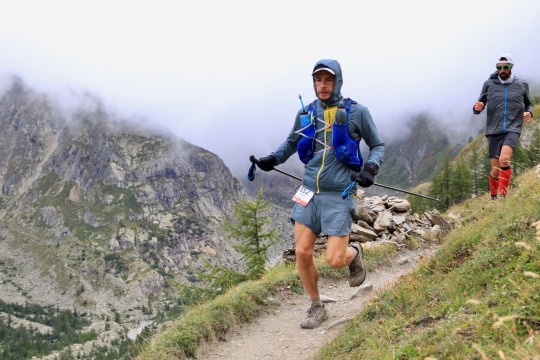
The long downhill to La Fouly was a segment I really struggled with in the past and it was just as tough this time. My legs weren’t really up for much running at this point but I pushed myself as much as possible knowing that I’d make up time and possibly avoid doing the last three mountains with a headlamp. The plan was working. While I didn’t shave off drastic amounts of time from running, keeping the aid station stops to a minimum began to add up. Refill bottles, get coffee, sit and eat for few minutes, grab more food while walking out. Repeat ad nauseum. I hit Champex Lac before 4pm, about 01:45h ahead. Best of all, I was able to climb the third last mountain in daylight, leaving my headlamp off until Trient (141km). By now, I had been running with the same group of people for hours. With the end sort of within reach, everyone loosened up. We chatted about our shared dread of upcoming segment or informed each other of the dramatic turn of events that took place amongst the elites (so many DNFs!), making the time pass faster and the endeavour more bearable. What wasn’t bearable was my downhill running. Every single muscle was complaining and my brain was too tired to coordinate the feet over the technical terrain. Bad combo. Still, I must have been moving in some fashion because I was suddenly through Vallorcine (152km) and hiking up the last climb. Ah, the last climb. It’s actually two climbs, interrupted by an extremely steep and technical (albeit short) downhill. I recalled how frustrating that treacherous downhill was, and how much anguish I had felt upon hearing of the second climb. But this time, I came prepared. As I made my careful ascent and descent, I passed two runners staring at their mobile phones who asked if they were on the right track. I reassured them that they were, not losing the opportunity to spread the good news of the second climb ahead. Just paying it forward. La Flégère, 8km from and 900m above the finish line in Chamonix. I had been running for around 31 hours and 10 minutes. Sub-32 sounded tempting but also a bit too ambitious, considering the state of my legs. The first 5km of the last downhill stretch is technical and steep. No need to do anything stupid and risky at this point. With 3.5km to go, the trail smoothed out and as if placements would matter at this point, some guys behind me started charging. And well, so did I. I caught a person after a minute who subsequently also picked up the pace. In no time, we were a small group having a little 3km sprint to the finish. Or at least it felt like a sprint. I was breathing hard and sweating, although the actual pace wasn’t any faster than my regular jogging pace. But things are different after 32 hours. I entered the town closely followed by four other runners. A few meters later my girlfriend Esther was cheering me on at the base of the pedestrian overpass. This metal contraption, by the way, was a new addition for the race. I suppose UTMB had to erect this temporarily as it could no longer block the road for the event. According to Esther, it gave some runners unexpected grief. Stairs or no, I still ran as hard as I could towards the finish.
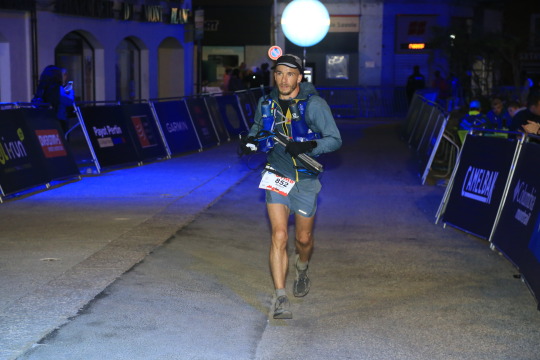
32 hours 06 minutes. 2:06 am. 2 hours and 47 minutes faster than 2017. 190th place overall. And one black toe nail.
So what have I learned from my second time at UTMB? That I can save so much time by just efficiently progressing through aid stations. And with slightly better descents (downhill splits after 100km actually were slightly slower than last year), I am certain that it should be possible to finish under 30 hours. It might have even been feasible this year, if I had concentrated the training solely on UTMB. I also learned from both WSER and UTMB that I can gain quite a lot of motivation from splits, either chasing or running away from them. Running in the mid-pack can sometimes lack the urgency and splits can add back some of the necessary tension and excitement into the sluggish sections. Plus they can provide reassurance and objectivity when I often feel slower than I actually am towards the latter parts of races. Nutrition: I ate mostly aid station food: noodle soup during the first cold and wet half of the race, coffee with cake and a dozen mini Snickers during the second half. Occasional GU-chews. Water in one bottle and 70/30 cola-water mix in the second. Did not feel bonky or bloated and no major stomach issues as expected on slower-paced races.
Strava
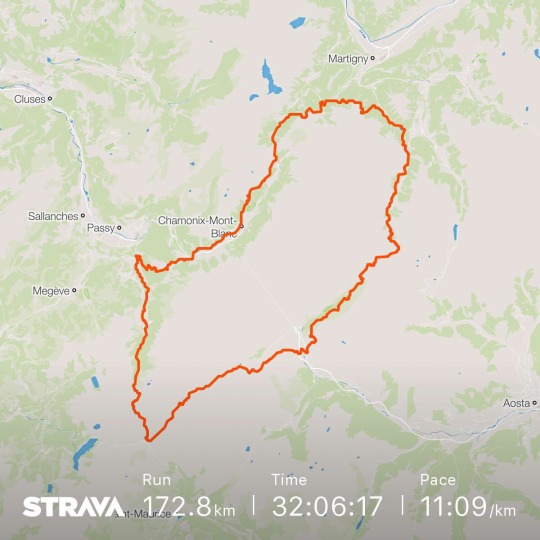
0 notes
Text
Race Report: Western States 100, 2018
Getting into Western States 100 on only two lottery tickets felt like a privilege I should approach humbly and seriously. And after a choppy start into the year recovering from a calf strain in January, I put in a 3-month block of training with more mileage, elevation and consistency than ever before.

That didn’t lighten the intimidating nature of this race and the goal of getting a silver buckle by finishing under 24 hours but at least I had done what could be done and was in good shape when we flew over to California ten days before race day.

Our first stop was Mammoth Lakes, near Yosemite National Park where I got to run and climb a bit and me and my girlfriend Esther went for hikes almost every day. Maybe not the best location for the recommended heat training but running, hiking and sleeping at 2600-3300m altitude and getting a few longer climbs and downhills than I can do at home was certainly beneficial as well, be it just to ease my mind. Wednesday in race week we headed over to Squaw, checked into our Hotel and I started to get more nervous. We attended a BBQ in Auburn, where I got to meet my pacer Scott Brand, whom I’d found via the Western States website, where potential pacers and runners could connect. The rest of the week passed quickly and the small village of Squaw charged up with anticipation every day as more runners, crews and media arrived. Everyone was talking about the looming weather prognosis which predicted a very hot race day with temperatures beyond 40C in the Canyons. As the race day temperature went up a degree every day I opened the weather app, I stopped checking superstitiously. I talked to a couple of veterans of the race to get a few tips. Most mentioned the importance of taking long dips in as many creeks as possible, the recommendations ranged from 30 seconds to 10 minutes. Many also agreed on wearing a cotton shirt instead of fast drying functional or merino ones. I’d always claimed that I loved heat but now I was a bit anxious about it. The day before the race we had lunch with the two other Swedish runners Anders Norén and Johan Steene and their families. My original plan of just relaxing the last few days and not get too immersed in the rising pre race tension in the village didn’t work at all, as I watched every single Irunfar live interview with the top contenders and went into a last minute shopping frenzy. I’ll never change. After my two drop bags were turned in , the race briefing (more heat talk) was attended, and my running vest was packed, I ate some simple pasta and headed to bed at 8.30pm. We had tried to preserve a bit of the jet lag the week before as the race started at 5. The alarm clock went off at 3.30, I had slept pretty well, rushed to the coffee machine and ate a toast before we took the 5 minute walk to the start. I received my Bib and with still 40 minutes to go I went inside and nibbled a bit from the pre start breakfast buffet. With a few minutes to go I positioned myself right in the middle of the starting field. With only 369 runners it wouldn’t really matter, unlike at UTMB where starting to far behind could mean having to queue on trails later on. Runners and the crowds counted down from ten and the gun went off.

We ran a few meters before everyone except the top runners calmed down and most of us transitioned into a hurried hike. The first 6km up to Escarpment and then Watson’s Monument climbed around 750m on a steep ski access road to the races highest point of around 2700m. The sun rose during that climb and the snow capped mountains and Lake Tahoe were a majestic sight for those of us who took a moment to look around at the top.

After a few hundred meters of descent from the top, the course winded along on top of several ridge lines for 20km with short climbs and descents. I eased into a nice relaxed rhythm, enjoyed the breathtaking views when I didn’t have to look down onto the surprisingly rugged, rocky and technical terrain. During that time I passed the first two aid stations and it already became apparent how fantastic the volunteers were. There were about 1700 for a few hundred runners. They’d approach when entering the aid stations, ask what they should fill into the bottles, if I need anything else and wished good luck with the race.

After around 30km a longer descent into Duncan Canyon started. The trail became a bit softer but was still quite technical. I noticed that Meghan Laws, a legend of Western States, was running behind me. She has been delivering consistent top 20 results for more than a decade and was running her 12th Western States. If anyone knew how to pace themselves smart for this tough course, it’s her. That company was certainly reassuring. During the following long climb to Robinson Flat it started to heat up. As I reached the aid station at short past 11, 6 hours into the race, the volunteers asked if I’d like ice. I had some poured into my buff and in my arm sleeves which were just cut off stockings I had gotten from my girlfriend. I wasn’t a big fan of iced arms I noticed instantly. It turned them numb from the cold so I decided for the rest of the race to use water on my arms and the ice in my buff and in my running vest instead. A short climb after Robinson Flat the course turned downhill for around 30km, at first on a beautiful single track, then easy, runnable but very exposed and dusty fire roads and 3 aid stations (with fitting names like Dusty Corner and Last Chance ) later on steep switch backs into the first major canyon. To the rhythmic rattle of the slushy ice in my vest I descended lower and lower through increasingly hotter pockets of air. I got passed by Meghan Laws again and tried to hang on. As we reached the bottom of the canyon she just ran passed the creek to climb up on the other side. I’d do as being told by people before the race and prepared to get wet and cold. I took off my vest went to the edge of the creek and descended awkwardly backwards into the water with my only my feet hanging onto the ledge to leave my shoes and socks dry for a bit longer. I was soaking like that for 3 minutes, dunked my head under water a couple of times and finally climbed out, feeling physically refreshed and mentally almost enthusiastic about how enjoyable that was.

The ascend up to Devils Thumb aid station was very steep and climbed around 600m over 3-4km and 36 switchbacks. I had felt pretty good at uphill hiking all day and even more so now as I was cooled down from the water. I caught a couple of people and passed even Meghan whom I hadn’t thought to see again. That short burst of actual and perceived strength carried me all the way up, down the next even longer and deeper canyon to El Dorado Creek and up again to Michigan Bluffs Aid Station, 55 Miles (88km) in. I loved the Canyons, my legs were my friends and I even liked the weather! The ice in the vest did cooling wonders and so did the cotton shirt. Crossing a couple of creeks, I eventually got wet feet, and combined with the heat I felt that the balls of my feet got a irritated. I had my first drop bag at Michigan Bluffs AS and planned on changing into fresh dry merino socks before I would get blisters. As a volunteer noticed me grabbing a pair of socks from my bag, she asked if my feet were ok and I went “Well..” she told me there was the best guy to fix my feet right here. John Vonhoff, author of “Fixing your feet”, who I had heard on several running podcasts, regularly volunteers at that aid station and within seconds I laid down on a chair, he ripped off my socks and applied some preventive taping. He wasn’t only treating my feet but also gave a little lecture about foot health and how to cut and file toe nails (even shorter!). Just when I thought, he’ll offer me his book to buy, he was done. At the same time his assistants had filled up my bottles and brought food telling me they wanted me out as fast as possible to not waste time. I couldn’t believe their engagement and within 15 minutes I was gone with fresh, dry and taped feet. During the next section I ran with and talked to a guy named Philip Sanderson who was running his third “Grand Slam”, consisting of four 100-milers within 11 weeks, with Western states being the second one. He told me we were about to enter “the canyon no one tells you about” (Volcano canyon, indeed, had never heard of it) and that he had still high hopes for a sub 22 finish. I shrugged that off at that moment but felt reassured that I was doing very well gaining a nice useful margin for my 24h goal.

I hiked up to Forest Hill (98k) where I met Scott, my pacer. He greeted me with “you are crushing it so far!” We ran along the road through Forest hill with dozens of trailers parked on the sides by either runner crews or spectators and an electrifying atmosphere. Now we’d start the last 62km and the next 30 of those were the most runnable of the whole course. We hit Cal street, a soft winding mostly downhill single track, high up with magnifying views over canyons and American River. I ran in front of Scott who told me he was glad we possibly could make it almost all the way to the river in daylight which would save us even more time. On an uphill we caught up to fellow Swede Johan Steene and his pacer. Exchanging a few encouraging words we moved on. While the downhills started to hurt at this point, I felt still strong on the ascends. I was really longing for reaching the river now but while I could see it down there for hours, the trail even descended all the way down at one point, just to climb up a few hundred meters again, it was a very long tease. Eventually we reached the river in the last daylight. The crossing was somewhat symbolic for me. There were only 35km left, a distance I run often and which feels approachable and not abstractly long. Also almost no runner ever quits once having passed the river.

I started paying attention to the signs at the aid stations which showed goal times for 24 and 30 hour finishes. At the river crossing I was apparently 1 hour and 45 minutes ahead of my 24 hour goal. If I just kept moving I’d certainly make it. If I kept moving as I had so far, why not aim for 23 hours or even less, I thought and mentioned it to Scott, probably secretly fishing for more reassurance. He just dead panned back “25, 24 or 22 hours, it all depends how much you’re willing to run”. Not exactly what I wanted to hear, running was painful at this point but he was right of course and it certainly kept me moving. After stepping through the river, holding onto ropes, we put on our head lamps and began the steep climb up to Green Gate. I enjoyed the climbing more and more as it meant a pleasurable rest from the quad pounding running. That didn’t last for long as we reached the top and entered Auburn lake trails, a 10km or so long rolling section which was (sadly) mostly runnable. Runnable was a relative term for me now, as I entered my only mental low point at the whole race but kept in a running or rather shuffling gait despite the painful legs. I kept myself distracted by the increasingly difficult task of converting miles to kilometres but it didn’t help. Kilometres felt like miles and miles like eternity. I think, not really knowing Scott too well, benefited my race, as I wasn’t comfortable enough to openly start a pity party. Neither did I want him to have to dead walk for hours as he volunteered to run 62km with a total stranger. The few moments I walked for a couple of seconds I almost excused myself and said “just catching my breath” or ate and drank something to create a legitimate reason to walk a few meters. That extra incentive kept me running/slogging while I just could have walked it home and probably would have on my own. We passed a couple of more runners and as at Brown bars aid station a volunteer informed us we were “only 5 minutes short of a 22 hour finish” I regained a bit of motivation. We were still making up time despite moving what felt pretty slow. Having a cheerful Hal Koerner, an ultra runner veteran, who volunteered at Pointed Rocks aid station, filling up my bottles and jokingly scaring me about the next climb just raised my mood even more. At No Hands Bridge, the last aid station with only 5km to go, we were 10 minutes below 22 hours finish splits. We had switched position with another runner and his pacer a couple of times during the last hour and were just right now in front. Excited and riled up from the chasing headlamps, I just ran through the aid station without eating or refilling bottles saying, “We are being followed!” One long last climb, with the last steep part on asphalt roads in the outskirts of Auburn, a celebratory feeling started setting in. The climb took forever, but soon we saw houses, cars and asphalt. We jogged through the sleeping town, passed another runner and Scott briefed me about where to enter the Placer High school track to run a final lap into the finish. He’d turn before that and meet me at the finish. Entering the track, my weak shuffle magically turned into a semi gracious running gait while “Tropical John” announced my arrival, giving details of my life I didn’t remember having given beforehand. It felt surreal and wonderful and maybe for the first time since 20km into it I wished the race would go on just a little bit longer, another lap on the track maybe.

I finished in 21 hours and 46 minutes (51th overall and 35th male), around 2 hours earlier than what I had hoped and trained so hard for.

I was so tired that it took a few hours for the result to sink in but I felt a deep satisfaction somewhere inside. I thanked and hugged my pacer, greeted Esther and just laid down on the grass, mixing naps with cheering on incoming runners. We’d stay on the track for another 10 hours, watching until the last runner had arrived. The crowds cheered louder as the clock approached the 30 hour mark. Most impressive for me was Nick Bassetts finish after 29 hours who became the oldest finisher in history at the age of 73 more than 3 decades after his first WS. Equally inspiring was Diana Fitzpatricks sub 24 hour finish, a new record for 60+ year olds. The heat felt more relentless now than it had anytime during the race. I almost considered asking for more ice. Around lunch time the award ceremony started where everyone received their well deserved iconic belt buckle. Finisher medals/awards aren’t usually a big deal but this shiny buckle is a slightly different story for me. Traveling on for another week I added it to the small list of things (wallet, passport) I must absolutely not forget at motels.
0 notes
Text
Race Report: Zugspitz Ultratrail, 2017
I decided to run the 102km alpine race Zugspitz Ultratrail in preparation for UTMB, to get in some serious climbing, which is difficult in flat Sweden. It is also a Western States 100 qualifying race, which made it just more attractive.

The previous year, I ran the Lavaredo 120k and Tierra Arctic Ultra 120k. Both races went pretty well overall, but there were low points, death marches, DNF temptations, dawdling at aid station and at especially Lavaredo, snail-paced climbing with constant stops to catch my breath. There was a lot to improve. In other words, my confidence wasn’t very high and doing all my hill training on a steep 90m hill in Stockholm wasn’t that reassuring. Apart from my insecurities about long climbs at high altitudes, I felt I haven’t really nailed my nutrition in any 15+ hour race so far. I usually relied on gels and Tailwind, which often led to getting really tired of them after a few hours and becoming rather sloppy with eating and resorting to cola after a few energy dips. My goal for the race was to start conservatively and finish strong, especially considering the profile of the course which had 2/3 of the total climbing in the first half of the race:

To get the Western States qualifier I’d have to run under 22 hours. My A-goal was to stay below 18, mostly so that I could still get a good night of sleep post-race. Regarding nutrition, I planned on eating more salt from the beginning and listening to my body’s signal for hunger, rather than counting and forcing in calories like clockwork. Having heard great things about the aid stations, I looked forward to eating as much real food as possible. My friend Martin and I arrived in Garmisch-Patenkirchen on Thursday and headed to Grainau to pick up our bibs and join the pasta party on Friday. It was clear that ZUT is an efficiently and professionally organised event. No queues or stressed out volunteers were in sight despite thousands of runners on location picking up their start numbers for 5 different races and their free spaghetti.

After checking the gear for the last time and a few non-alcoholic beers later (another new strategy, the non-alcoholic part, not the beer), I slept surprisingly well for almost 7 hours until the alarm went off at 5am. Two hours later we were lined up at the start line.

The gun went off (not sure if there was a gun involved actually), a Bavarian marching band(!) led the 500 runners through the village for 300 meters. After a few kilometres we entered the forest and the path inclined into a long but not too steep uphill. I tried to stick to my “smart” conservative approach as much as possible, walking all uphills to keep it as light and easy as possible, avoiding heavy breathing and lactic acid in my legs. Rushing the start to avoid queuing later on wasn’t really necessary as the first 10-20 or so km was on relatively wide hiking paths. Eventually the endless uphill was interrupted by steep downhill sections to be followed by similar steep uphill passages on single tracks and ski pistes. It became obvious that the course is quite technical and rugged. I tried to find the right balance on the downhills to save my legs by neither slowing down and breaking too much nor running down as if stung by bees.

Martin seemed to have a great day and kept running 50-100 meters in front of me most of the time. Was he trying to drag me, pushing me to running faster? I felt good but cautious after an epic bonk 40-50km into Lavaredo last year so I tried to ignore him as much as possible and told him to not hold back or wait for me at the next aid station. I really wanted to be able to run the 25km flat part later in the race. We usually have a fairly loose commitment of sticking together as long as it feels natural and no one is having a major crisis. I love the company of good friends in races but have become a bit more aware of the importance of running my own race lately. It’s impossible to synchronise the high and low points in long races and sticking to the lowest common pace isn’t a smart strategy when you have a time goal.

We would however stay together for another 20-30 km and the long uphill to the highest point of the race became a very enjoyable hike. The aid stations were fantastic, loaded with fresh fruits, broth, cheese, sandwiches and cake. I stuck to eating real food, Scratch labs sport drink, and nibbled on some Powerbar chews. The Gu gels were left untouched for the entire duration of the race. We took a lot of photos of the landscape which was slowly shifting from forest, green grass with the sound of cowbells to more rugged high alpine environment.

There were two major climbs and descents before the half way point and even though my muscles were a bit tight, I felt good and the steep 1000 meter descent into the 55km aid and drop bag station was great adrenaline inducing fun. I had lost Martin a while ago on the uphill as he struggled a little with nagging knee and a slight loss of energy. I messaged my girlfriend in Stockholm to send some pictures and videos and to tell her that everything was fine. I also took the opportunity to check for placement (49th) and Martin’s position to evaluate if it was worth waiting for him at the next aid station or continue onto my own race. He was apparently some 20-30 minutes behind, a little too long to wait. I felt great coming into the drop bag station at 55km, changed my shirt, charged my watch for 10 minutes and ate and drank all I could. I rushed off maybe a bit to eagerly as I noticed three kilometres later that I had left my poles at the station. I ran 100 meters back, did some quick sloppy math and decided poles weren’t worth 30 minutes of extra running. I wasn’t too experienced with poles and doubted they were making me any faster. Of course, they certainly helped in keeping some leg and back muscles stay upright on uphills. But the next 25 kilometres were going to be flat and I wouldn’t have to worry until 85k and probably could grind it out in the end.

With considerably fresh legs and high spirits I ran through the flat valley, passed quite a few runners. I repeatedly checked my placement with my girlfriend. After hearing that I was at the 30th position 70 km in, a bit of competitiveness kicked in and motivated me to push further. The course slowly turned to be more hilly but also more spectacular. A few steep canyons on mostly forest switch backs and ridges later, the last 1200m uphill started. It was a steep and endless endeavour but I felt still great and kept passing a couple of runners on my now pole-less hike. The upper part of the hill was a 7km loop. Knowing that the middle of the loop also was the peak and beginning of the final steep downhill helped me march on without wasting time at the 87k aid station. By the time I hit Alpspitzbahn Bergstation at 92km, all the climbing for the day were behind me and I entered an almost too glorious, victorious state of mind. There was still 1300 meters to descend over 8km, but I felt pretty confident and planned to hammer down the hill as quickly as possible. It was getting cold at the top and darkness was approaching. I put on my jacket, gloves and headlamp and rushed off.

I made the decision to switch my 700 Lumen NAO for a much lighter 300 Lumen Black Diamond Spot before the race but I regretted that choice after a few meters in the dark. The upper part of the single track was covered in fist sized rocks, the lower forest part in mud, roots and steps and every extra light illuminating the ground would have helped. I tried to keep a running pace while staying cautious. The last thing I would need is falling off a cliff or breaking my legs after a tumble. I passed a lot of people, most of them running the shorter 80k Supertrail XL. Finally after 40 minutes I reached the outskirts of Grainau and having 2km of paved roads left I started to run as hard as I could to finish in 15 hours and 38 minutes (21th overall finish/19th in group). Celebrations were in order and I cheerfully drank 3 beers while mulling over the results. Shaving off more than two hours from my time goal was unexpected but more importantly, I succeeded in following through with my goals for nutrition and strong finish. Martin also stayed well below our 18 hour goal although he had to use his poles as crutches to descend the mountain to support his bad knee. The Zugspitz Ultratrail is a memorable race both in its beauty and difficulty. It’s also a well organised event with fantastic volunteers and aid stations and offers 5 different distances 25 to 100km - suitable for almost every runner. I recommend it!

0 notes